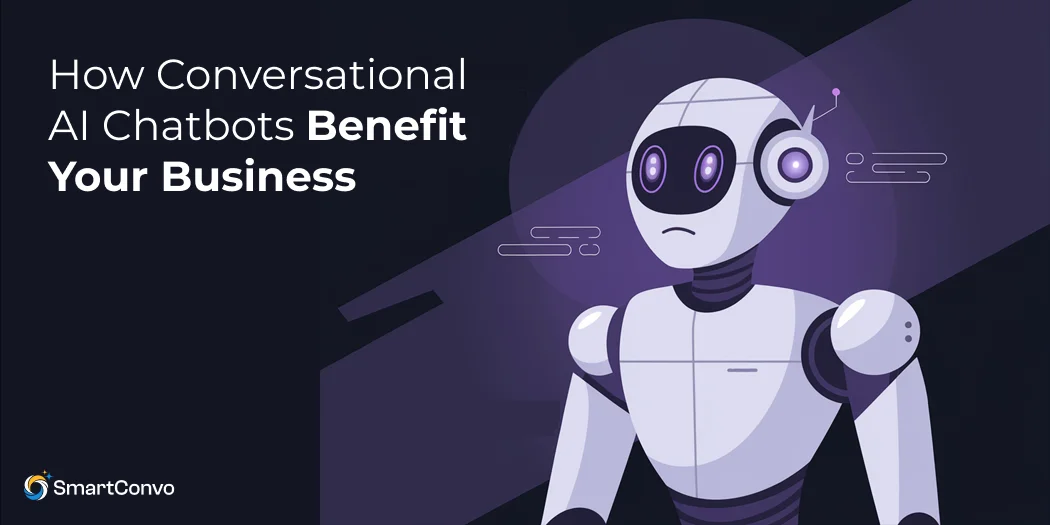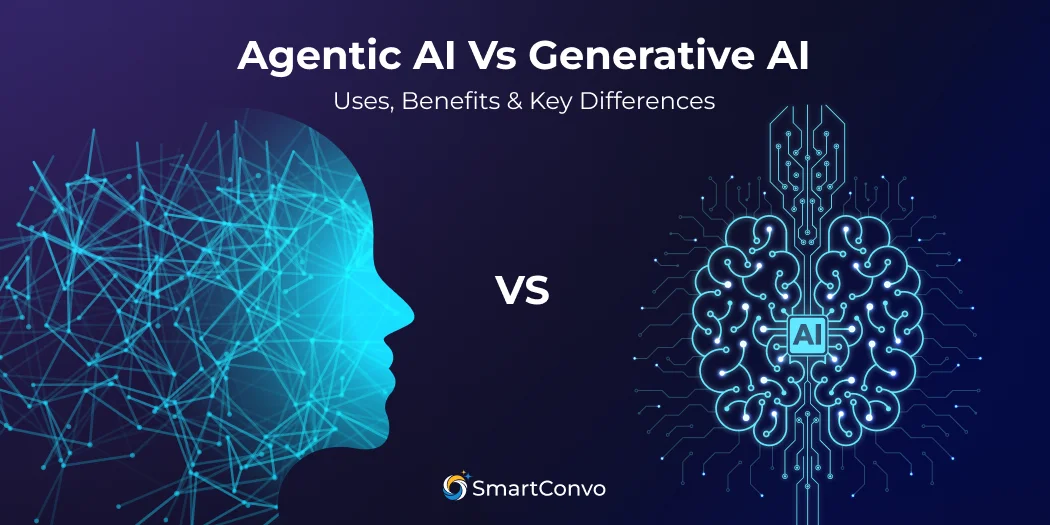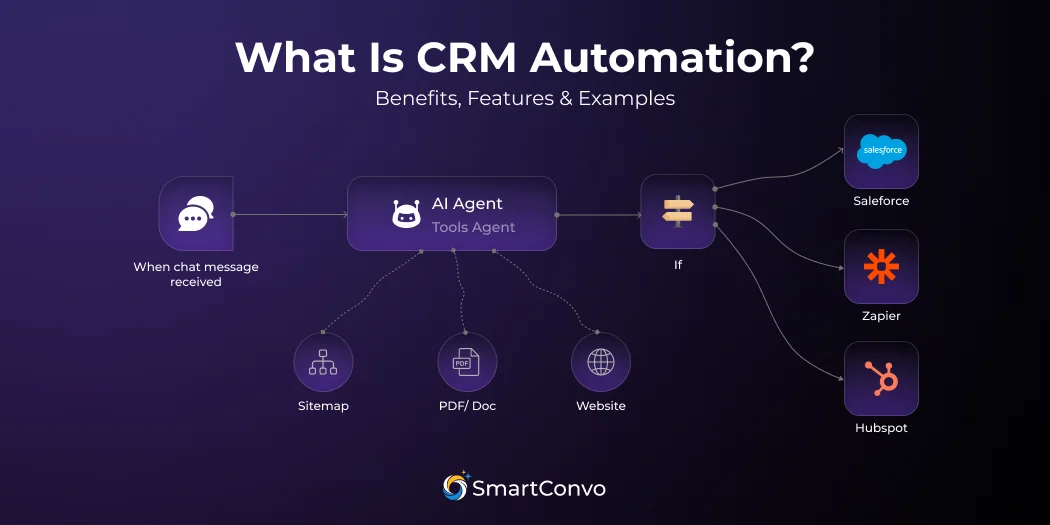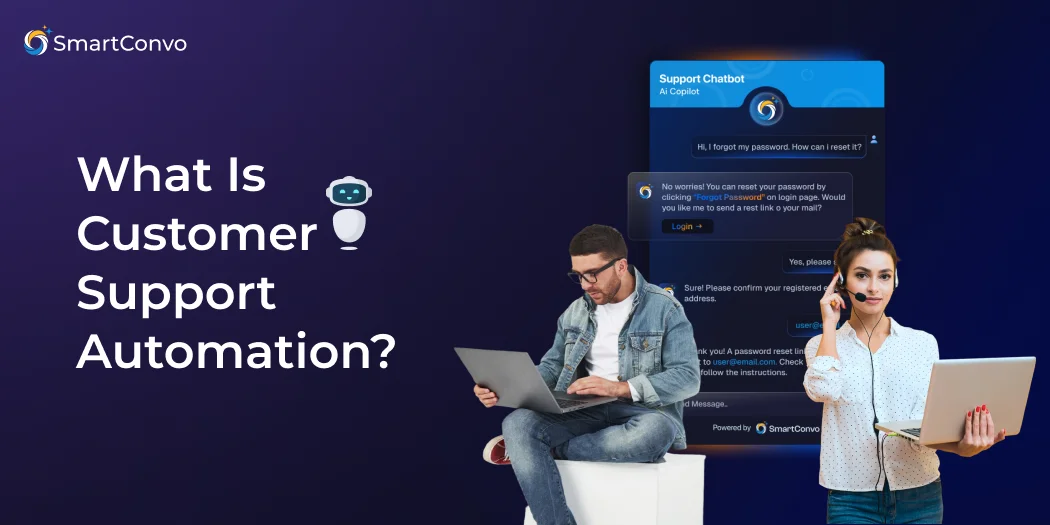Small businesses and e-commerce stores face an ongoing challenge—providing exceptional customer experiences while managing limited resources and keeping up with growing demands. Enter conversational AI chatbots—an innovative tool that has redefined the way businesses communicate with both their customers and employees. These intelligent systems are no longer limited to answering simple FAQs; they now engage with users in meaningful ways, assist with complex inquiries, and resolve problems in human-like, empathetic interactions, all in real-time.
Conversational AI chatbots can be a game-changer, offering around-the-clock support without the need for a large customer service team. They can handle high volumes of queries simultaneously, freeing up human staff to focus on more strategic tasks. Additionally, they can be tailored to reflect a brand’s voice and tone, creating a personalized experience that builds trust and loyalty.
But what exactly makes conversational AI chatbots so valuable for businesses, and how do you ensure their successful implementation? From improving customer satisfaction and reducing response times to streamlining internal processes and driving sales, these bots have the potential to transform operations. This blog delves into the key benefits of AI chatbots, practical tips for their integration, and real-world examples of how they’re helping businesses thrive in today’s competitive landscape.
What Are Conversational AI Chatbots?
Conversational AI chatbots are advanced virtual assistants powered by natural language processing (NLP) and machine learning. Unlike traditional AI chatbots that operate on scripted responses, conversational AI understands context and sentiment, making interactions feel seamless, personalized, and intelligent.
These chatbots can hold adaptive conversations across multiple channels, such as websites, messaging apps, and social media. Whether resolving a customer’s query or guiding an employee through a complex task, AI chatbots for business serve as the backbone of modern communication systems.
Why is Conversational AI Better Than Traditional AI Chatbots?
Traditional chatbots rely on predefined scripts and operate in narrow parameters. Conversational AI, however, focuses on understanding intent and providing relevant responses. Key differences include:
- Contextual Understanding: Conversational AI adapts to multi-turn conversations, following context even when the user switches topics.
- Natural Language Interaction: It uses advanced NLP to understand user inputs in their natural form, including slang or typos.
- Continuous Learning: Utilizing machine learning, it improves over time by analyzing interactions and feedback.
With these capabilities, conversational AI delivers a human-like experience unmatched by traditional chatbots.
How Do Conversational AI Chatbots Work?
Conversational AI combines several technologies to process and respond effectively:
- Natural Language Processing (NLP) processes user inputs to extract meaning.
- Machine Learning (ML) refines future responses based on past interactions.
- Speech Recognition enables voice-based conversations.
- Dialog Management Systems manage the conversation flow.
These features ensure that conversational AI chatbots provide seamless, fast, and accurate assistance, highlighting the benefits of conversational AI in delivering personalized user experiences.
Conversational AI Benefits for Employees
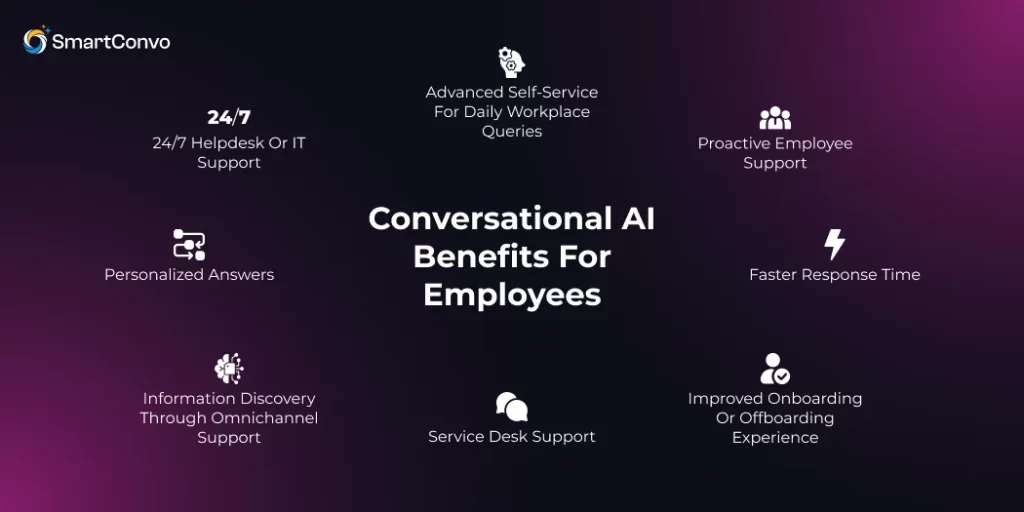
Conversational AI chatbots do more than assist customers—they empower employees to work more efficiently, improving their overall experience. One key conversational AI benefit SaaS business owners are leveraging is the ability to streamline operations and enhance user engagement. Here’s how:
Advanced Self-Service for Workplace Queries
Employees can use AI chatbots for a variety of business queries, such as checking HR policies, leave balances, or resolving common IT troubleshooting issues. These chatbots are designed to provide quick and accurate responses, reducing the need to wait for human assistance. For instance, an HR Knowledge Management chatbot can instantly answer questions about company policies, benefits, or holiday entitlements, helping employees save time and focus on their work.
24/7 IT or Helpdesk Support
Chatbots act as round-the-clock helpdesk assistants, providing instant support and significantly reducing wait times for resolving IT issues. They can handle a wide range of queries, from password resets to troubleshooting common technical problems, ensuring employees get the help they need without delays, even outside regular business hours.
Enhanced Onboarding and Offboarding
AI chatbots play a crucial role in guiding new hires through onboarding and departing employees through offboarding processes. They provide step-by-step instructions, answer common questions, and ensure no important details are missed. By offering a personalized experience, these chatbots streamline the process, reduce the workload for HR teams, and help employees feel supported during transitions.
Omnichannel Information Discovery
Through seamless integrations with systems like the company’s Knowledge Base for HR, employees can easily access necessary documents, policies, or guidelines whenever they need them. Whether it’s through email, chat apps, or the company intranet, this system ensures employees have quick and convenient access to important information, reducing delays and improving overall efficiency in the workplace.
Simplified Service Desk Support
By streamlining minor tasks like password resets, conversational AI employee service desk chatbots significantly reduce the workload on IT teams, allowing them to focus on more complex and strategic projects. These automated tools can handle routine inquiries quickly and efficiently, improving response times and overall productivity within the organization.
Faster Response Times
Prompt responses enhance productivity in the workplace. For example, a HR chatbot for employee engagement can address feedback instantly, resolving concerns before they escalate.
Personalized Answers
By analyzing past interaction data, chatbots can generate responses that are specifically tailored to user preferences or needs. This involves identifying patterns in conversations, understanding user intent, and applying machine learning to deliver more personalized and relevant interactions, improving the overall user experience.
Proactive Employee Support
Chatbots can predict employee challenges by analyzing patterns in workload and behavior. For example, during periods of high workload, conversational AI for employee support can proactively suggest helpful resources such as time management tips, stress-relief exercises, or tools to streamline tasks. This support helps employees stay productive and reduces the risk of burnout.
Conversational AI Chatbots Benefit For Your Business
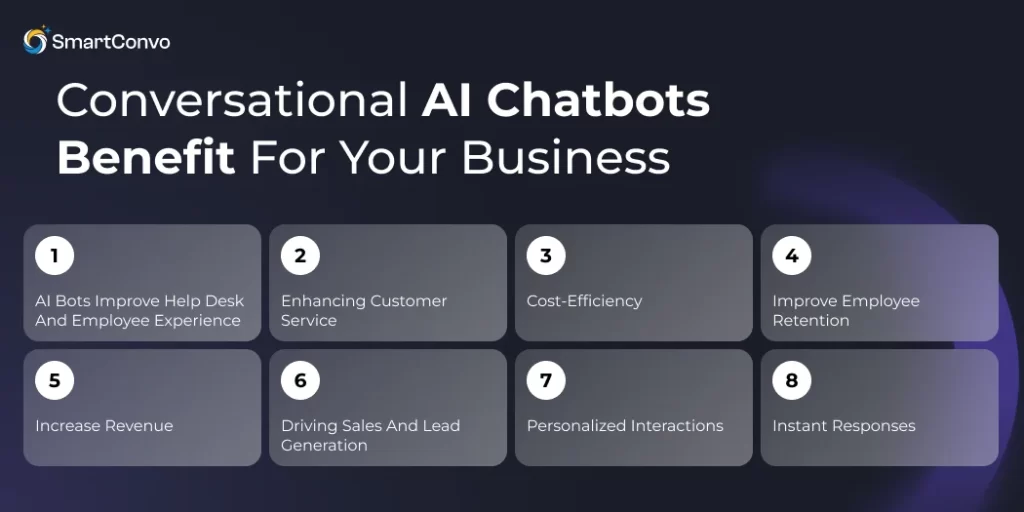
When implemented correctly, conversational AI chatbots drive immense value for your organization. Below are key benefits for businesses and customers, highlighting the significant AI chatbot advantages for your business.
Streamlined Help Desk and Employee Experience
By automating mundane and repetitive tasks such as answering FAQs, scheduling appointments, or managing basic customer inquiries, chatbots free up employees to focus on more complex, high-priority work. This shift not only reduces time spent on routine activities but also enhances overall productivity and allows teams to dedicate their energy to tasks that drive greater value for the organization.
Enhancing Customer Service
Chatbots ensure consistent, 24/7 availability to address customer queries, providing instant responses regardless of the time or day. These AI-powered tools are capable of managing high volumes of inquiries simultaneously, which not only improves efficiency but also reduces wait times for customers. By taking care of repetitive or straightforward questions, chatbots free up human agents to focus on resolving more complex or sensitive issues, ultimately enhancing both productivity and customer satisfaction.
Cost-Efficiency
By reducing the need for additional staff, businesses can save significant operational costs, allowing them to allocate resources more efficiently. This approach not only helps manage budgets effectively but also ensures that businesses can maintain a high-quality customer experience by focusing on streamlined processes and leveraging technology or existing teams to meet customer needs.
Improve Employee Retention
Efficient onboarding programs and streamlined processes, powered by conversational AI, play a crucial role in enhancing employee satisfaction and boosting morale. By simplifying training, providing instant support, and personalizing the onboarding experience, conversational AI helps new hires feel more confident and connected. This leads to higher productivity, reduced turnover, and a stronger, more engaged workforce.
Increase Revenue
Chatbots play a significant role in increasing revenue by enhancing customer satisfaction through quick and efficient support, reducing churn by addressing issues proactively, and creating upselling opportunities during personalized interactions. By being available 24/7, chatbots ensure customers feel valued and supported, while their ability to analyze user behavior allows them to recommend relevant products or services, further boosting sales.
Driving Sales and Lead Generation
Chatbots analyze sales trends by processing vast amounts of data to identify patterns and opportunities. They then initiate personalized lead-conversion conversations with potential customers, providing timely recommendations and answers to inquiries. This streamlined approach helps businesses enhance customer engagement and secure consistent revenue growth.
Personalized Interactions
Using generative AI, AI-driven personalization helps retain customers by creating tailored experiences that meet their specific needs and preferences. Whether they’re browsing an e-commerce store, receiving product recommendations based on their past purchases, or booking a service with options customized to their behavior, this approach enhances satisfaction and loyalty by making every interaction feel unique and relevant.
Instant Responses
Prompt replies ensure customers and employees both experience time efficiency, which is crucial for maintaining satisfaction and fostering long-term retention. Quick responses demonstrate reliability, build trust, and show that their time is valued, which can significantly enhance overall engagement and loyalty.
How to Build a Custom Chatbot for Your Business
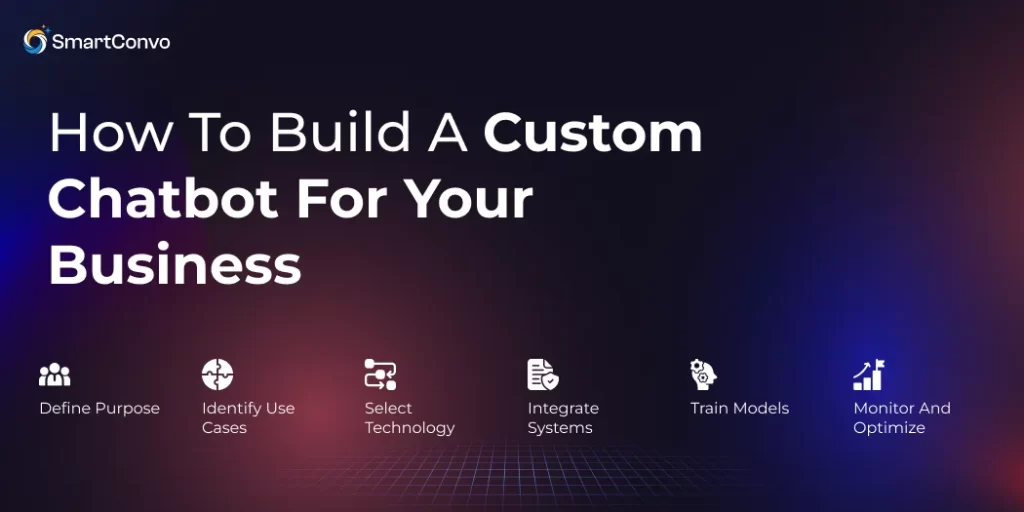
Define Purpose
Start by identifying what you want your chatbot to achieve. Is it designed to handle customer service inquiries, improve employee engagement, or boost sales? Clearly defining its purpose will help you tailor the chatbot’s features, tone, and responses to effectively meet your goals and provide the best possible experience for users.
Identify Use Cases
Detail the areas where the chatbot will have the most impact. For example, HR chatbot can significantly improve employee engagement by answering common questions, assisting with onboarding, and providing real-time support for workplace concerns. Similarly, e-commerce bots can drive sales by recovering abandoned carts through personalized reminders, offering product recommendations, and assisting customers throughout the purchasing process.
Select Technology
Choose an AI platform that fits your specific needs and goals. Explore a variety of options, including generative AI models for creating content, designs, or ideas, and LLM chatbots for enhancing customer interactions or automating support. Take the time to evaluate features, scalability, and how each tool aligns with your requirements to ensure you find the perfect fit.
Integrate Systems
Ensure your chatbot integrates seamlessly with existing tools such as CRMs, HR case management systems, and customer databases to streamline workflows, improve data accuracy, and enhance overall efficiency. This compatibility allows your team to access real-time information, automate repetitive tasks, and deliver a smoother user experience.
Train Models
Feed your chatbot accurate and well-structured datasets to significantly enhance its ability to recognize user intent and deliver precise, contextually relevant responses. By providing high-quality training data, you ensure your chatbot can effectively understand a variety of user inputs and improve its overall performance in real-world interactions.
Test and Optimize
Test your chatbot in a variety of scenarios to ensure it performs effectively in different situations. Regularly evaluating and refining its responses will help optimize its performance over time, improving user experience and overall functionality.
Monitor and Refine
Keep a close eye on how users are interacting with the chatbot and gather regular feedback to understand their needs and concerns. Use this information to make small, thoughtful adjustments that can improve the chatbot’s effectiveness, ensuring it provides a more seamless and satisfying user experience over time. Regular monitoring and fine-tuning will help the chatbot stay relevant and helpful.
No Credit Card Required | 14 days Free Trial
Build Your Chatbot
Conclusion
From transforming customer service to revolutionizing conversational AI workplace support and efficiency, AI chatbots are no longer a luxury—they’re a must-have for businesses aiming to stay competitive.
By exploring tools like conversational AI and leveraging AI Chatbots for HR Management, businesses of all sizes can enhance communication, reduce costs, and improve the overall experience for employees and customers alike.
Want to start your AI chatbot transformation? Begin by defining your goals, selecting the right technology, and integrating AI across crucial business functions. Build your first chatbot and watch as it streamlines your operations and maximizes your impact.
Frequently Asked Questions (FAQ)
AI chatbots save time, deliver instant responses, and improve customer and employee satisfaction by automating repetitive tasks while providing personalized support.
Conversational AI uses NLP and machine learning to provide contextual, natural-sounding responses, making it more adaptive and user-friendly.
From e-commerce to HR, conversational AI is revolutionizing industries that depend on systematic communication, real-time problem-solving, and customer interaction.
Many vendors offer scalable AI chatbot solutions that cater to small businesses, allowing them to start small and expand capabilities as they grow.




